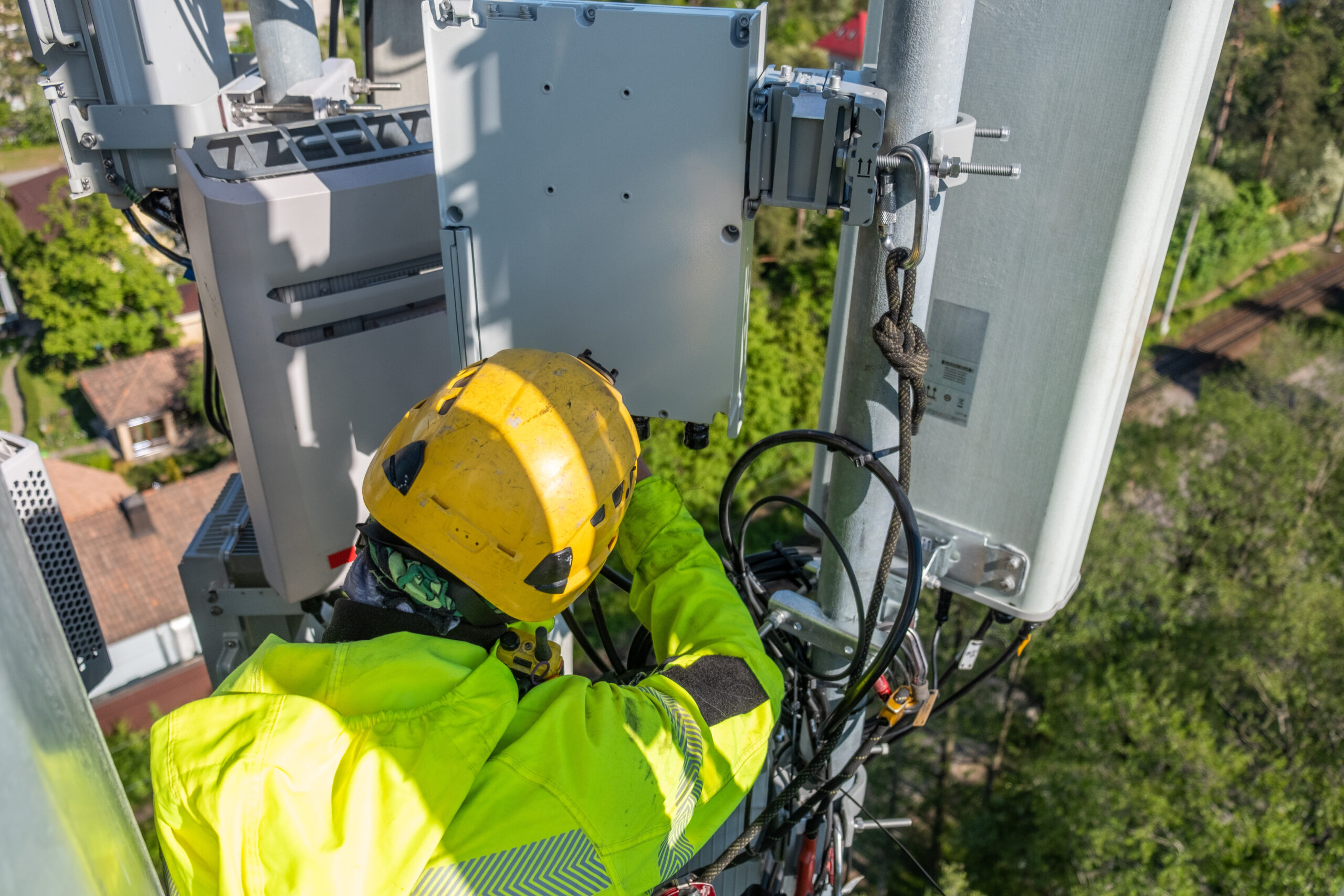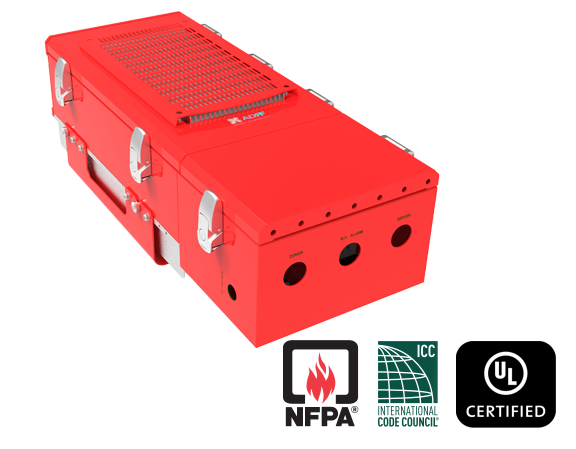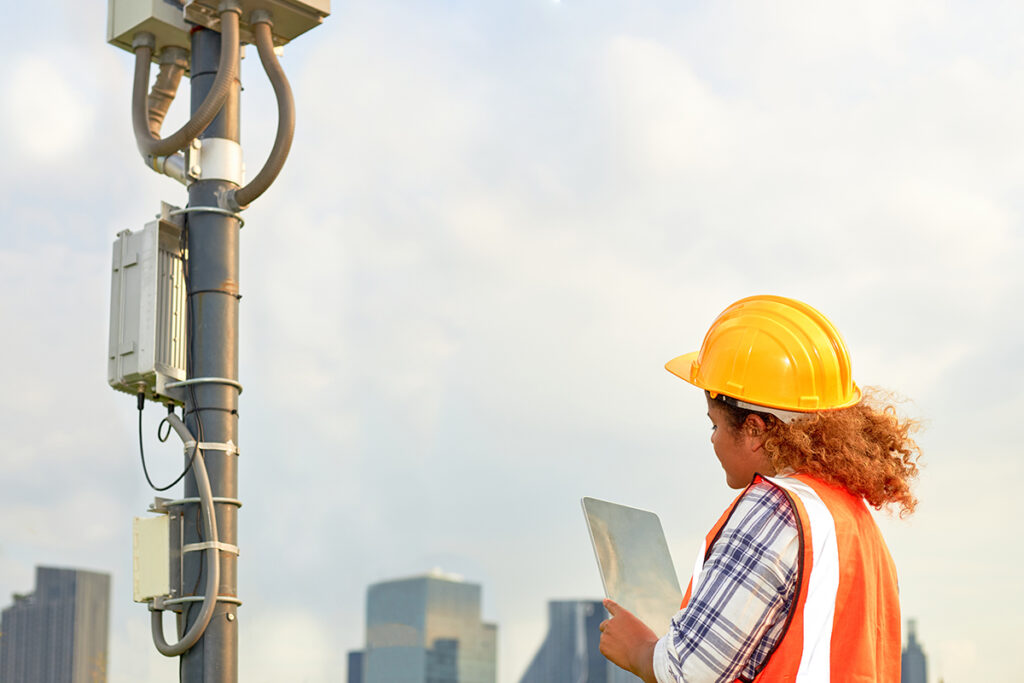How Can RFE Communications Assist With ERRCS?
An ERRC system, or Emergency Responder Radio Coverage System, is essentially a communication lifeline within buildings for firefighters, police, and other emergency services. Imagine being in a large concrete building where your cell phone signal barely works; that’s often the case for emergency radios, too. ERRCS is designed to ensure that crucial lines of communication are clear and reliable during emergencies, allowing first responders to communicate effectively inside buildings, underground, or in other challenging environments.
RFE Communications is dedicated to providing our clients with top-quality installation services for Emergency Response Radio Communication (ERRC) systems. Our team of experienced technicians is trained to handle all aspects of the process, from planning and design to execution and ERRCS testing. We understand the importance of reliable communication in emergencies, which is why we take every precaution to ensure that your system is installed correctly and efficiently. Our technicians are equipped with the latest tools and technology to ensure your system is up and running as soon as possible.
What Is an ERRCS?
Emergency Response Radio Communication systems are used to provide reliable communication in emergency situations. These systems are typically used by emergency response teams, such as fire departments, police departments, and ambulance services, to communicate with one another and coordinate their efforts.
These systems can be used in a variety of settings, including buildings, schools, hospitals, and other large facilities. They are designed to be reliable and easy to use, even in high-stress situations.
They typically consist of a network of radios, antennas, and other communication equipment specifically designed to operate in an emergency. They may be connected to a central dispatch center, allowing emergency responders to communicate with one another and receive updates and instructions.
These systems are essential for ensuring strong radio signals so that emergency responders have the communication tools they need to effectively respond to emergencies and keep the public safe.
Common Key Components of an ERRCS
- Antennas: These are like the system’s ears and mouth, receiving and sending out signals. Small antennas are placed throughout the building to ensure coverage in all areas, including those tricky spots like basements or deep interiors where signals usually don’t reach.
- Bi-Directional Amplifier (BDA): Think of this as a signal booster. It takes the weak signals from the emergency radios and amplifies them, making sure the communication is loud and clear, both within the building and back to the emergency services outside.
- Donor Antenna: This is positioned outside the building, often on the roof, to catch the signals from the nearest emergency communication towers and bring them into the building’s system.
- Signal Source: Some systems might use a dedicated signal source that ensures even more reliable access to the emergency frequencies needed.
- Cabling: Just as veins carry blood throughout your body, cables carry the signals to and from the antennas and the BDA, ensuring the entire building is covered.
How Emergency Responders Use the System
Emergency responders have radios that operate on specific frequencies reserved just for them. These frequencies are not used by other types of communication systems, ensuring that emergency responders have uninterrupted communication when needed most. When they enter a building equipped with an ERRCS, their radios can tap into this amplified network, allowing them to communicate with each other inside the building and with external support teams without interference or signal loss. This system ensures that, in the heat of the moment, communication is clear, coordination is effective, and operations can be conducted more safely and efficiently.
They may also be linked to a central dispatch center that enables emergency responders to communicate with each other and receive important updates and instructions. This functionality is essential for coordinating response efforts and ensuring that emergencies are managed effectively.
Imagine a firefighter needing to coordinate with their team about how to tackle a fire on a different floor or police needing to communicate silently while responding to a situation. ERRCS makes all this possible, ensuring that the heroes who run into buildings when everyone else is running out can do their jobs as safely and effectively as possible.

Should I Use an ERRCS to Ensure Reliable Emergency Communication?
Whether or not you should use an Emergency Response Radio Communication system depends on your specific needs and circumstances. If you are responsible for managing the communication needs of an emergency response team or if you are in charge of the communication infrastructure at a large facility, this may be a good option for you. These systems can help ensure that emergency responders have the communication tools they need to respond to emergencies and keep the public safe.
However, if you are an individual or a small business owner, an ERRC system may not be necessary. Other types of communication systems and tools may be more appropriate for your needs. It is important to carefully consider your communication needs and budget when deciding on the right choice.
RFE Communications ERRC systems and installation services include:
Site survey and assessment: Our technicians will conduct a thorough site survey to determine the best location for your system. We will take into account factors such as signal strength, line of sight, and power availability to ensure optimal performance.
Planning and design: Once the site survey is complete, our team will work with you to create a customized plan for your system. This will include determining the number of radios and antennas needed, as well as the placement of all equipment.
Installation: Our technicians will handle all aspects of this process, including mounting antennas, installing radios, and setting up power and data connections.
Testing and commissioning: Next, our team will conduct thorough testing to ensure that your ERRC system is working properly. We will also provide training on how to use and maintain the system.


ERRCS Requirements
ERRC systems are required by law in certain situations. For example, the International Fire Code (IFC) mandates that new and existing buildings must have adequate coverage for first responders. This means that the system must be capable of providing reliable communication in all areas of the building, including stairwells, elevators, and other locations where radio communication may be challenging. Other local and state regulations may also require the installation of these systems in specific situations, such as hospitals, schools, and other large facilities. These regulations are put in place to ensure that emergency responders have the tools they need to communicate effectively during emergency situations.
If you are unsure whether your building or facility requires an ERRC system, it is important to consult with a qualified professional who can help you determine your compliance obligations. Failure to comply with these regulations can result in costly fines and penalties, and more importantly, can put the safety of first responders and the public at risk. RFE Communications can help building owners gain clarity and provide customized solutions.
Contact Us for ERRCS Installation Services Nationwide
RFE Communications is your partner in securing buildings with state-of-the-art emergency responder radio coverage systems. Our team of experts works closely with building owners, managers, and local authorities to design and install ERRCS solutions that meet specific needs and comply with all regulatory requirements. We offer nationwide installation services, ensuring that your building is equipped with reliable radio systems that support the crucial work of emergency services.
Whether you’re upgrading an existing structure or constructing a new building, RFE Communications has the expertise to ensure optimal radio coverage for emergency responders. Contact us today to learn more about our ERRCS installation services and how we can help make your building safer for everyone.
Our Other Communication Solutions
In addition to our ERRCS installation services, RFE Communications offers a variety of solutions to meet your communication needs:
FAQ
RFE Communications understands that you may have questions about our services and how they can benefit your commercial property. These FAQs address common concerns and inquiries related to our ERRCS installation solutions, the testing process, security, and other essential aspects of our services and to help you make informed decisions and gain a deeper understanding of our offerings. Our goal is to provide you with valuable insights and information that will allow you to optimize your wireless infrastructure and enhance the overall connectivity experience for your building’s occupants.
What makes RFE Communications' ERRCS installation services stand out from the rest?
Our team of experienced technicians is equipped with the latest tools and technology to ensure your system is installed correctly and efficiently. We also conduct a thorough site survey and assessment to determine the best location for your system and create a customized plan for your specific needs.
Why are these systems important?
These systems are essential for ensuring that emergency responders have the communication tools they need to effectively respond to emergencies and keep the public safe. In high-stress situations, reliable communication is critical for coordinating efforts and ensuring the appropriate resources are deployed.
Who should consider using an Emergency Response Radio Communication system?
These are typically used by emergency response teams, such as fire departments, police departments, and ambulance services, to communicate with one another and coordinate their efforts. If you are responsible for managing the communication needs of an emergency response team or if you are in charge of the communication infrastructure at a large facility, this may be a good option for you.
How are the systems installed?
The installation process for an ERRC system will vary depending on the specific system and the location where it is being installed. In general, the process may include a site survey to determine the best location for the system, planning and design of the system, installation of the equipment, and testing and commissioning of the system.
How does an ERRCS provide reliable communication in emergency situations for my commercial building?
These systems operate on dedicated frequencies that are specifically reserved for emergency responders. These frequencies are not used by other types of communication systems, ensuring that emergency responders have uninterrupted communication when it is needed most. They may also be linked to a central dispatch center that enables emergency responders to communicate with each other and receive important updates and instructions.
Are ERRC systems expensive?
The cost of a system will depend on various factors, including its size and complexity, the location where it is being installed, and any additional features or services that are included. In general, systems can be more expensive than other types of communication systems due to the specialized nature of the equipment and the system’s importance in an emergency.
Are these systems required by law?
Yes, they are required by law in certain situations. For example, the International Fire Code (IFC) mandates that new and existing buildings must have adequate coverage for first responders. These systems are now required on buildings three or more stories or with an area greater than 50,000 square feet or containing underground parking. Other local and state regulations may also require the installation of these systems in specific situations, such as hospitals, schools, and other large facilities.
What types of buildings benefit most from an ERRCS?
An ERRC system is essential for maintaining emergency services communications systems within various types of buildings. These systems are crucial for ensuring that emergency responders can communicate effectively in environments where radio signals might otherwise be weak or non-existent. Here are the types of buildings that benefit most from installing an ERRC system:
- High-Rise Buildings: The structure and height of high-rise buildings can significantly impede the ability of emergency responders to receive radio signals. An ERRC system ensures that radio communications are clear and uninterrupted, no matter the floor level.
- Commercial Complexes: Shopping malls, entertainment centers, and large office buildings with complex layouts and dense materials need robust radio systems to ensure safety in emergencies.
- Hospitals and Healthcare Facilities: These buildings are not only densely populated but also contain equipment and infrastructure that can interfere with radio signals. An ERRCS supports the critical work of emergency medical teams by providing reliable communication paths.
- Educational Institutions: Schools, colleges, and universities must be prepared for emergencies, making ERRC systems vital for the safety of students and staff across sprawling campuses.
- Underground Facilities: Parking garages, subways, and tunnels are challenging environments for radio communications. ERRC systems are specifically designed to extend radio coverage into these and other heavily shielded areas.
- Industrial and Manufacturing Plants: The presence of heavy machinery, metal structures, and vast spaces can hinder emergency communications. An ERRCS ensures that all areas of the plant are covered, protecting both workers and assets.
Building owners and managers must collaborate with local authorities to meet the required standards for emergency communications. An ERRC system not only complies with these standards but also significantly enhances the safety and security of occupants by ensuring that emergency responders have the communications support they need.





